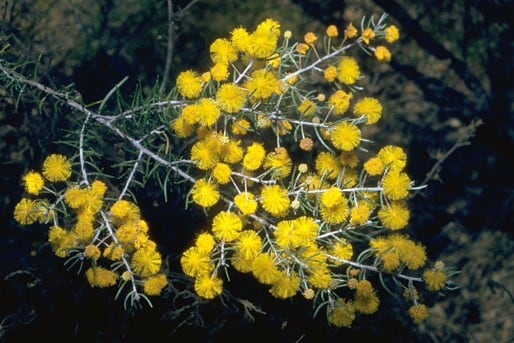Acacia hendersonii Pedley
WATTLE
Acacias of Australia
Family
Fabaceae
Distribution
Confined to the Blackdown Tableland, an isolated sandstone plateau in Qld that supports an interesting flora, including a number of endemics.
Description
Spreading, much-branched shrub to 3 m high, glabrous, somewhat resinous. Branchlet ribs tuberculate. Phyllodes scattered or a few irregularly subverticillate or subfasciculate, rather crowded, ±patent to inclined, linear, mostly shallowly to moderately incurved or sigmoid, flat, (10–) 15–22 mm long, 0.7–1.1 mm wide, abruptly constricted at base with pulvinus 0.2–0.5 mm long, excentrically mucronulate, somewhat thick, often longitudinally rugulose adjacent to the sometimes indistinct midrib when dry, gland minute, to 1 mm above pulvinus. Inflorescences simple, 1 per axil; peduncles 9–15 mm long, ebracteate at base; heads globular, 30–35-flowered, light golden. Flowers 5-merous; calyx shallowly dissected. Pods (depauperate) narrowly oblong, 5–7 mm wide, firmly chartaceous. Seeds not seen but longitudinal judging from pods.
Specimens
Qld: Tableland, western escarpment, I.RTelford 5739 (BRI, NSW).
Notes
A member of the ‘A. johnsonii group’ closely resembling A. johnsonii which is most readily distinguished by its shorter peduncles and hairy branchlets that are neither prominently ribbed nor tuberculate. It is also close to the more widespread A. resinicostata which differs in having generally shorter phyllodes that are ±sessile (i.e. pulvinus absent or vestigial). Contrary to protologue there appears to be no gland present at apex of phyllode adjacent to the mucro.
FOA Reference
Data derived from Flora of Australia Volumes 11A (2001), 11B (2001) and 12 (1998), products of ABRS, ©Commonwealth of Australia
Author
B.R.Maslin
This identification key and fact sheets are available as a mobile application:
URL: https://apps.lucidcentral.org/wattle/
© Copyright 2018. All rights reserved.









